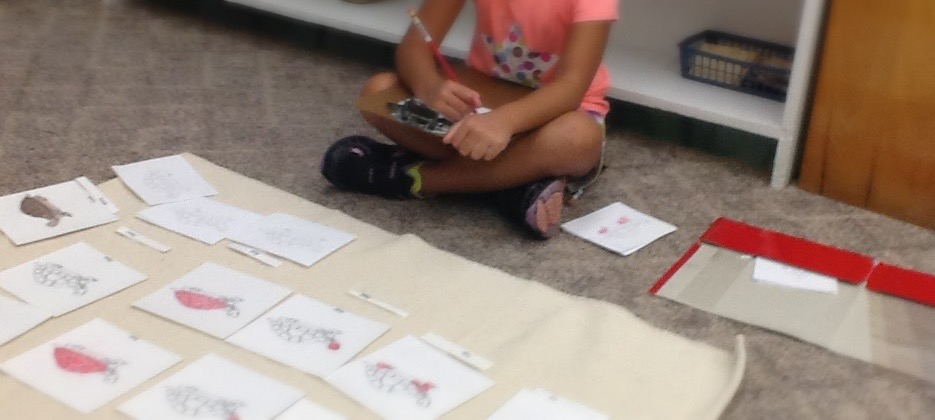
Once children have begun to write letters, they are quickly motivated to apply that knowledge to useful, meaningful activities. But a child who wants to write a lot may not yet have the attention span or endurance to write for long. It falls, then, to the creative Montessori teacher to identify opportunities for children to write things that are important to them, without overwhelming them with more writing than they may be able to complete.
Enter the nomenclature cards. The nomenclature cards offer a common structure for learning language throughout the Cultural materials. From the Latin nomen + clatura, or “assigning names,” the nomenclature cards build children’s vocabulary. Sometimes called, “three-part cards,” the nomenclature cards include a control card with a simple line drawing of a whole system, for example a fish, a flower, or a horse, illustrated above a label identifying a point of interest. The control cards are matched to two smaller cards: one with only the illustration and one with only the label. A set of cards for the parts of a flower, then, would include one card with a full color line drawing of a flower labeled “Flower,” plus additional cards highlighting the leaf, petals, pistil and so on. These composite sets can be prepared for any vocabulary that includes parts and wholes: parts of animals, parts of cells, parts of trees, parts of musical instruments, parts of a book, etc. Once the child understands the structure of the nomenclature cards, they can use the system for any cards available in the room.
For pre readers and early readers, they may compile the cards without reading the labels at all, matching the shapes they see on the control card to the shapes they see on the labels. This is a fairly straight-forward task for the very young child, who has a natural ability to notice small differences. For early writers, though, the nomenclature cards offer practice forming letters and meaningful application for that practice. For these learners, the teacher will make available blank copies of the line drawings, encouraging the child to color in each of the individual parts and write the letters they see on the associated label. A child, for example, who may not yet have the mastery to write words of their own design, can write the labels and color the parts for all the composite parts of a guitar. When they’re finished with the individual sheets, they can collate them into a small book, folding a construction paper cover around their finished sheet and writing out “Parts of a Guitar” for a title. Children are motivated to prepare these little books and enjoy the sense of accomplishment they feel when they have completed all the individual pages and enclosed them in a cover. For developing writers, these little books give children practice with meaningful writing as they carefully write out each label, and practice managing a stylus as they color in the associated part on each page. While any one book may only demand five or six written words, the compiled pages are a real accomplishment, satisfying the child’s interest in writing with purpose without overwhelming their length of attention.
To an adult observer, the nomenclature cards may seem quite simple: the child is matching pictures to control cards. What’s hard about that? But for the young child, these are often absorbing activities, drawing attention to the small differences between the colored drawings and giving an opportunity for meaningful practice in writing. Creating the little books, sometimes with the pages misaligned, sometimes with staples in the wrong place, is an authentic challenge for the child, who wants to see it through to the end. Remember: it’s the process of making these materials that drives the child, not the end product. A child may work for hours on a little book, just to discard it when it’s done. That’s ok. The child is satisfied by the experience of writing real things with importance, whether or not they remember to bring those little books home.
#Writing #Nomenclature #ForParents #CulturalMaterials #Language #Primary #FirstPlane
